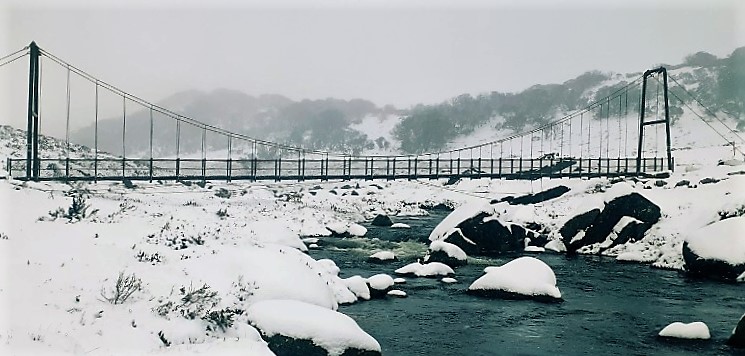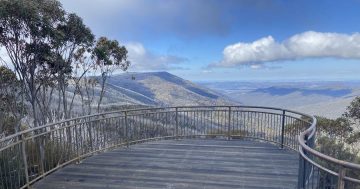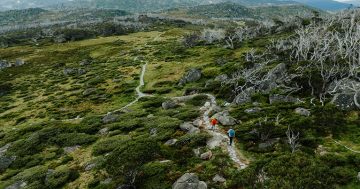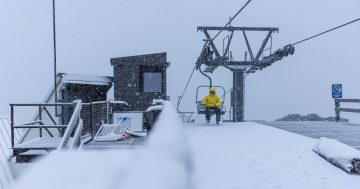
Unseasonal snow has caused delays to construction of the Snowies Alpine Walk which was expected to be completed this summer. Spencers Creek bridge in fresh snow. Photo: Aleksandr Cahill/DPE.
If there exists a contingency plan for construction of the beaut new Snowies Alpine Walk within Kosciuszko National Park, workers might wonder if it covered off falls of snow in October, November and December.
But that’s what they’re up against right now in a year when significant wet weather has already delayed progress and now unseasonal weather drops temperatures well below zero and delivers a white Christmas for Santa who might need to ditch the six white boomers in favour of reindeer.
Indeed though, the Snowies Alpine Walk is living up to its name as it snakes through the mountains toward the completion of the final two stages now delayed, but still within sight of a summer 2023 finish.
If you haven’t yet heard of it, the project carries the distinction of offering a world-class, multi-day walk across the alpine roof of Australia for both domestic and international visitors.
It’s a 55-kilometre, four-day adventure full of highs – including the opportunity to summit Australia’s highest peak, Mount Kosciuszko, and walk the length of Australia’s highest suspension bridge as the trail dips and threads its way – effectively extending existing walks across Kosciuszko National Park to link the resorts of Guthega, Charlotte Pass, Perisher and Lake Crackenback.
Stage one – rerouting of the Main Range Track – was completed in 2019 and that means visitors are now scrambling up Mt Lee via a steel mesh walkway instead of grabbing gravel with their boots.
The walkway was constructed as part of a realignment of 1.7 kilometres of old track to bypass and therefore protect one of the rarest plant communities in the world, the windswept feldmark, a critically endangered ecological community.
Rehabilitation of the old track continues as the NSW National Parks and Wildlife Service (NPWS) works hand-in-hand with Australian National Botanic Gardens in Canberra to trial propagation and germination methods to supply plants for the project.
According to the NPWS, this a long process but one buoyed by early propagation success with coral heath (Epacris microphylla) cuttings.
June this year saw the opening of the second stage – the Guthega to Charlotte Pass Walk – complete with its showy new suspension bridge, the highest in Australia.

Workers are now pushing to complete stages three and four of the 55-kilometre track. Photo: Steelworks Engineering.
Standing 1627 metres above sea level, the Spencers Bridge spans the Snowy River between Guthega and Charlotte Pass and forms part of the recently constructed nine-kilometre track along the upper Snowy River.
What lies ahead are stages three and four, with the Charlotte Pass to Perisher section originally scheduled to open this month, but wet weather delays mean it’s now slated to open in March 2023.
The NPWS says more than nine kilometres of this 9.8-kilometre new section of track from Charlotte Pass village to Porcupine Rocks is complete, with some more remote sections of track and the final leg leading into the Charlotte Pass village still to be signed off.
Construction on stage four of the walk from Perisher to Bullocks Flat kicked off in January 2022 with work well underway in the lower altitudes near Bullocks Flat but construction in the sub-alpine sections delayed due to wet weather and snow.
Again, steel mesh and rock paving is being used to protect sensitive habitats.
At this stage, NPWS says planning work to upgrade the existing Perisher track head is well underway.
This track head will provide critical carparking, signage and other facilities for visitors walking from Perisher to Charlotte Pass (including the Porcupine Walk) and Perisher to Bullocks Flat.
Summer visitors should be aware that carparking during these works will be limited and some diversions around the construction site may be in place.
Despite this, these final works are due for completion in summer 2023.
Those planning to visit the park this summer are asked to check local alerts or call ahead before setting out on walks.
NPWS has provided a trip intention form to send important details about your trip to your emergency contact.












